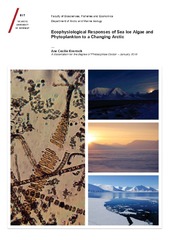Blar i forfatter "Kvernvik, Ane Cecilie"
-
Arctic sea ice algae differ markedly from phytoplankton in their ecophysiological characteristics
Kvernvik, Ane Cecilie; Hoppe, Clara Jule Marie; Greenacre, Michael; Verbiest, Sander; Wiktor, Józef Maria; Gabrielsen, Tove M.; Reigstad, Marit; Leu, Eva (Journal article; Tidsskriftartikkel; Peer reviewed, 2021-05-20)Photophysiological and biochemical characteristics were investigated in natural communities of Arctic sea ice algae and phytoplankton to understand their respective responses towards variable irradiance and nutrient regimes. This study revealed large differences in photosynthetic efficiency and capacity between the 2 types of algal assemblages. Sea ice algal assemblages clearly displayed increased ... -
Ecophysiological Responses of Sea Ice Algae and Phytoplankton to a Changing Arctic
Kvernvik, Ane Cecilie (Doctoral thesis; Doktorgradsavhandling, 2019-03-29)The ice-covered seas of the Arctic have two major types of primary producers; phytoplankton growing in open waters and sea ice algae growing within and on the underside of the sea ice. This thesis investigates the controlling role of light availability on Arctic pelagic and sympagic (i.e. ice-associated) algae, and how light-induced responses are modulated by NO3 and pCO2 levels. A combination of ... -
Seasonal plankton dynamics in Kongsfjorden during two years of contrasting environmental conditions
Assmy, Philipp; Kvernvik, Ane Cecilie; Hop, Haakon; Hoppe, Clara J.M.; Chierici, Melissa; David T., Divya; Duarte, Pedro; Fransson, Agneta; García, Laura M.; Patuła, Weronika; Kwaśniewski, Sławomir; Maturilli, Marion; Pavlova, Olga; Tatarek, Agnieszka; Wiktor, Jozef M; Wold, Anette; Wolf, Klara K.E.; Bailey, Allison Michelle (Journal article; Tidsskriftartikkel; Peer reviewed, 2023-02-24)Seasonal plankton time-series data are presented from Kongsfjorden from two years with contrasting environmental conditions. Kongsfjorden (west coast of Spitsbergen – 79°N) integrates inputs from Atlantic and Arctic waters, and glacier run-off, and is thus a prime location to study impacts on ecosystem dynamics of key environmental drivers that are relevant across the Arctic. Despite extensive ...


 English
English norsk
norsk

